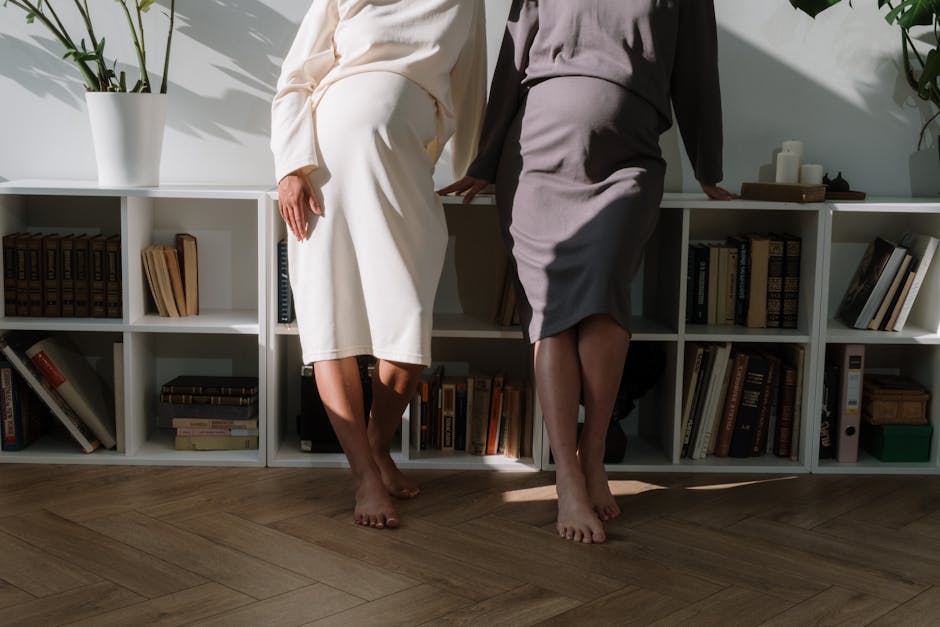Creating a minimalist living room that’s both stylish and functional when you have small kids can feel like a real juggling act. It’s about finding that sweet spot where simplicity meets practicality, ensuring a space that’s calm, clutter-free, and safe for your little ones. So, how do you embrace minimalist living room decor with kids around? Let’s explore some ideas and strategies for designing a family-friendly minimalist living room, tackling everything from selecting the right furniture to organizing toys and choosing kid-proof materials.
Understanding the Minimalist Approach for Families
Minimalism isn't just about getting rid of everything; its' about thoughtfully curating your possessions, prioritizing quality over quantity, and having only the things you really need and love. For families with children, this takes on a special meaning. It's about creating a space that feels calm and spacious amidst the delightful chaos that kids bring. It's about designing a space which encourages creativity and play, without becoming a dumping ground for toys and clutter.
Think of it this way: a minimalist living room for families isn't about sacrificing comfort or personality; it's about streamlining your life and creating a space that promotes relaxation and connection. Fewer possessions often means less to clean, less to worry about, and more time to spend with your loved ones.
Key Benefits of a Minimalist Living Room with Kids:
- Reduced Stress: A clutter-free environment can help to reduce stress and anxiety for both parents and children.
- Easier Cleaning: Less stuff means less to clean and organize, freeing up your time for other activities. A study from UCLA revealed that women who described their homes as "cluttered" exhibited higher levels of the stress hormone cortisol.
- Increased Focus: A minimalist space can help kids to focus on their activities and play, without being distracted by excessive toys and possessions.
- Enhanced Creativity: A more open and uncluttered space can stimulate creativity and imagination in children.
- Improved Safety: Reducing clutter also minimizes tripping hazards and other safety risks for young children.
Choosing the Right Furniture for Your Minimalist Family Living Room
The furniture you select for your living room plays a huge role in achieving a minimalist aesthetic. Consider these key factors when making your choices:
- Multifunctional Pieces: Opt for furniture that serves more than one purpose. For example, an ottoman with storage space can double as a coffee table and a place to stash toys or blankets. Sofas with built-in storage are also great for keeping clutter hidden.
- Durable and Easy-to-Clean Materials: Kids are messy! Choose furniture upholstered in durable, stain-resistant fabrics that can withstand spills and accidents. Leather, microfiber, and outdoor fabrics are good options. Also, think about surfaces that wipe clean easily.
- Simple and Clean Lines: Look for furniture with simple, clean lines and minimal ornamentation. Avoid overly ornate or bulky pieces that can make the space feel cluttered. A sofa with simple square arms, for example, will look less overwhelming than a rolled-arm sofa.
- Comfort is Key: Even in a minimalist space, comfort is essential. Choose furniture that's comfortable and inviting for both adults and children. Prioritize comfortable seating and soft, durable fabrics.
- Size Matters: Select furniture that's appropriately sized for your living room. Avoid overcrowding the space with oversized pieces. Measure your room carefully before purchasing any new furniture. Leave enough open space for kids to play safely.
- Consider Rounded Edges: To minimize bumps and bruises, particularly with toddlers running around, opt for furniture with rounded edges. Sharp corners can pose a safety hazard.
Examples of Minimalist Furniture Choices:
- Sofa: A simple, streamlined sofa in a neutral color like gray, beige, or navy.
- Coffee Table: An ottoman with storage, a simple wooden table, or a set of nesting tables.
- Armchairs: Two comfortable armchairs in a complementary color to the sofa.
- Bookshelf: A minimalist bookshelf for storing books and displaying a few carefully chosen decorative objects.
- Media Console: A simple media console with closed storage to hide electronic devices and cords.
Toy Storage Solutions: Taming the Chaos
Toy storage is possibly the biggest challenge in maintaining a minimalist living room with kids. Here are some clever storage solutions to help keep the chaos under control:
- Storage Baskets and Bins: Use a variety of storage baskets and bins to organize toys, books, and games. Label each bin clearly so that kids know where everything belongs. Consider using clear bins so that kids can easily see what's inside.
- Shelving Units: Install shelving units to create vertical storage space. Use shelves to display decorative items, books, and framed photos, while storing toys in baskets on lower shelves.
- Ottomans with Storage: As mentioned earlier, ottomans with storage are a great way to hide toys while providing extra seating or a place to rest your feet.
- Toy Rotation: Implement a toy rotation system to keep things fresh and prevent toy overload. Store some toys away in a closet or storage area, and rotate them every few weeks. This can help to keep kids engaged with their toys and reduce clutter in the living room.
- Dedicated Play Area (Optional): If you have the space, consider creating a dedicated play area in one corner of the living room. Define the area with a rug or play mat, and use storage bins and shelves to organize toys and books.
- Wall-Mounted Storage: Floating shelves, and other wall mounted solutions save floor space which is really key in a minimalist living room. They also add a design edge to the living room.
Pro Tips for Toy Storage:
- Involve Your Kids: Get your kids involved in the toy organization process. Teach them how to sort toys and put them away after playing.
- Purge Regularly: Regularly declutter your kids' toys. Get rid of broken toys, toys they've outgrown, and toys they no longer play with. Donate them to charity or sell them online.
- Make It Fun: Turn toy organization into a game. Sing a song, set a timer, or offer a small reward for completing the task.
Choosing a Minimalist Color Palette and Decor
The color palette and decor you choose can greatly impact the overall feel of your minimalist living room.
- Neutral Colors as a Base: Start with a neutral color palette for the walls, floors, and furniture. This will create a calm and serene atmosphere. Consider colors like white, gray, beige, or light blue. According to color psychology, lighter shades can help to make a room feel more spacious and airy.
- Add Pops of Color: Add pops of color with accent pieces like pillows, throws, artwork, or rugs. Choose colors that you love and that complement the overall color scheme. But don't go overboard! Too many colors can make the space feel cluttered.
- Less is More: When it comes to decor, less is more. Choose a few carefully selected decorative items that you truly love. Avoid cluttering the space with knick-knacks and trinkets.
- Natural Elements: Incorporate natural elements like plants, wood, and stone to add warmth and texture to the space. Plants can also help to purify the air and create a more inviting atmosphere.
- Artwork: Choose a few pieces of artwork that you love and that complement the overall aesthetic. Consider using minimalist prints or abstract art.
- Textiles: Use textiles like rugs, curtains, and throw pillows to add texture and warmth to the space. Choose fabrics that are durable and easy to clean.
Examples of Minimalist Decor Choices:
- Pillows: A few simple throw pillows in a solid color or a subtle pattern.
- Throw Blanket: A soft and cozy throw blanket in a neutral color.
- Artwork: A few framed prints or paintings in a minimalist style.
- Plants: A few potted plants, such as succulents or ferns.
- Rug: A simple area rug in a neutral color or a geometric pattern.
- Lighting: Simple and stylish lighting fixtures, such as a floor lamp or a pendant light.
Kid-Proofing Your Minimalist Living Room
Creating a safe and kid-friendly living room is essential when you have young children. Here are some tips for kid-proofing your minimalist space:
- Cover Sharp Corners: Use corner protectors to cover sharp corners on furniture and walls. This can help to prevent bumps and bruises.
- Anchor Furniture: Secure tall furniture like bookshelves and dressers to the wall to prevent them from tipping over.
- Hide Cords: Use cord organizers or cord covers to hide electrical cords and prevent kids from tripping or pulling on them.
- Use Non-Toxic Materials: Choose furniture, paint, and other materials that are non-toxic and safe for children.
- Remove Breakables: Remove any breakable items, such as glass vases or delicate sculptures, from the living room. Store them in a safe place where kids can't reach them.
- Install Safety Gates: Install safety gates at the top and bottom of stairs to prevent falls.
- Window Safety: Ensure that window blinds and curtains have cordless or breakaway cords to prevent strangulation hazards.
- Create a Safe Play Area: Designate a safe play area where kids can play without getting into trouble. Use soft rugs, play mats, and cushions to create a comfortable and safe space.
- Use Childproof Locks: Install childproof locks on cabinets and drawers to prevent kids from accessing dangerous items like cleaning supplies or medications.
Cleaning and Maintaining Your Minimalist Living Room
Maintaining a minimalist living room with kids requires a regular cleaning routine. Here are some tips for keeping your space clean and organized:
- Daily Tidy-Up: Make it a habit to tidy up the living room every day. Put away toys, fold blankets, and wipe down surfaces.
- Weekly Deep Clean: Once a week, do a more thorough cleaning. Vacuum or mop the floors, dust the furniture, and clean the windows.
- Declutter Regularly: Regularly declutter your living room. Get rid of items you no longer need or use. Donate them to charity or sell them online.
- Involve Your Kids: Get your kids involved in the cleaning process. Teach them how to wipe up spills, put away toys, and make their beds.
- Use Natural Cleaning Products: Use natural cleaning products that are safe for children and the environment.
- Spot Clean: Address spills and stains immediately to prevent them from setting in.
- Washable Fabrics: As mentioned earlier, washable fabrics are a must!
Embracing Imperfection: It’s Okay If It’s Not Perfect
While striving for a minimalist living room is admirable, remember that perfection is unattainable, especially with kids. Don't be too hard on yourself if your living room isn't always perfectly tidy. Embrace the imperfections and focus on creating a space that's functional, comfortable, and enjoyable for your family.
- Accept the Mess: Accept that there will be messes, especially with young children. Don't let the occasional mess stress you out. Just clean it up and move on.
- Focus on Functionality: Focus on creating a space that's functional for your family's needs. Choose furniture and storage solutions that make it easy to keep the living room organized.
- Prioritize Comfort: Prioritize comfort over aesthetics. Choose furniture that's comfortable and inviting for both adults and children.
- Make It Personal: Add personal touches to your living room to make it feel like home. Display family photos, artwork, and other items that you love.
- Enjoy the Process: Enjoy the process of creating a minimalist living room that's both stylish and functional for your family. Don't get too caught up in the details. Just have fun and create a space that you love.
The key to a successful minimalist living room for families is finding a balance between simplicity and practicality. It’s about creating a space that’s both aesthetically pleasing and functional for the whole family, kids included. By focusing on durable furniture, smart storage solutions, a calming color palette, and kid-proof design, you can create a living room that’s both stylish and livable.
Integrating Smart Home Technology into Your Minimalist Living Room
While minimalism emphasizes simplicity, integrating smart home technology can actually enhance the functionality and convenience of your living room without adding visual clutter. Here's how:
- Voice-Controlled Assistants: Devices like Amazon Echo or Google Home can control lighting, temperature, and entertainment systems with voice commands, eliminating the need for multiple remotes and switches.
- Smart Lighting: Smart light bulbs can be controlled via smartphone or voice, allowing you to adjust the brightness and color temperature to create different moods. Dimmable lighting can also be beneficial for kids.
- Smart Thermostats: Smart thermostats can automatically adjust the temperature based on your schedule and preferences, saving energy and ensuring a comfortable environment.
- Smart Entertainment Systems: Streaming devices like Roku or Apple TV can consolidate your entertainment options into a single, easy-to-use interface.
- Wireless Charging: Wireless charging pads can eliminate the need for multiple cords and chargers, keeping your surfaces clutter-free.
- Automated Blinds/Shades: Motorized blinds or shades that can be controlled via remote or smartphone can help manage sunlight and privacy.
- Hidden Technology: Conceal wires and cables with cable management solutions. Consider furniture with built-in charging ports or hidden compartments for electronics.
When choosing smart home technology, look for devices that are easy to use, reliable, and compatible with your existing systems. Consider whether it could integrate seamlessly with the rest of your living room.
Creating Zones Within Your Minimalist Living Room
Even in a minimalist space, designating specific zones for different activities can help to maximize functionality and organization. Consider these zones:
- Relaxation Zone: This zone should be centered around comfortable seating, such as a sofa and armchairs. Add a coffee table for drinks and snacks, and a few throw pillows for added comfort.
- Play Zone: Designate a specific area for kids to play. Use a rug or play mat to define the space, and add storage bins for toys and books.
- Reading Zone: Create a cozy reading nook with a comfortable armchair, a floor lamp, and a bookshelf.
- Entertainment Zone: This zone should be centered around the TV or media console. Add comfortable seating, a coffee table, and storage for media devices.
- Work Zone (Optional): If you work from home, consider creating a small work zone in one corner of the living room. Use a desk, a chair, and a lamp to create a functional workspace.
When defining zones, use furniture, rugs, and lighting to visually separate the different areas. This can help to create a sense of order and organization in your minimalist living room.
Budget-Friendly Minimalist Decorating Tips
You don't have to spend a fortune to create a minimalist living room. Here are some budget-friendly decorating tips:
- Shop Your Home: Before buying anything new, take a look around your home and see what you already have that you can use. You may be surprised at what you find!
- DIY Projects: Get creative and try some DIY decorating projects. You can make your own artwork, throw pillows, or storage bins.
- Thrift Stores and Flea Markets: Check out thrift stores and flea markets for affordable furniture and decor. You can often find unique and stylish pieces at a fraction of the cost of buying new.
- Online Marketplaces: Online marketplaces like Craigslist and Facebook Marketplace are great places to find used furniture and decor.
- Sales and Discounts: Take advantage of sales and discounts at your favorite stores. Sign up for email newsletters to receive exclusive offers.
- Repurpose and Upcycle: Repurpose old items to give them new life. For example, you can turn an old ladder into a bookshelf or an old suitcase into a coffee table.
- Focus on Essentials: Focus on buying only the essential items you need. Don't get caught up in trends or impulse purchases.
- Prioritize Quality: When buying new furniture, prioritize quality over quantity. Choose pieces that are well-made and will last for years to come.
- Neutral Palette: Choosing a neutral color pallette for your walls and larger furniture pieces let you change up smaller accessories with ease. Accessories and easy to change elements are generally cheaper than entire furniture sets.
By following these tips, you can create a beautiful and functional minimalist living room without breaking the bank.
Last modified: June 14, 2025



